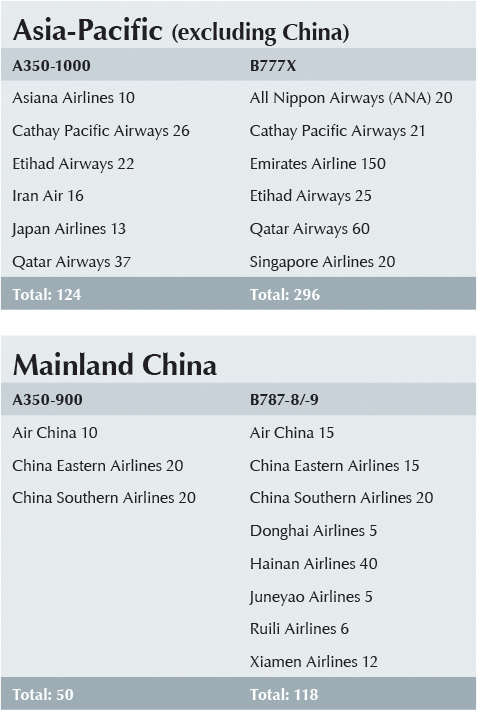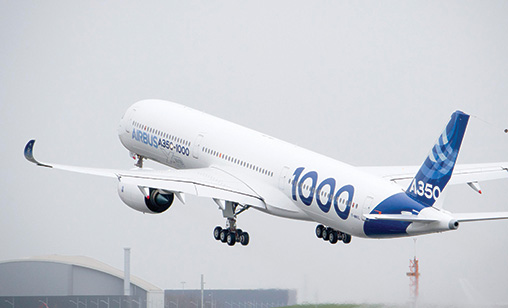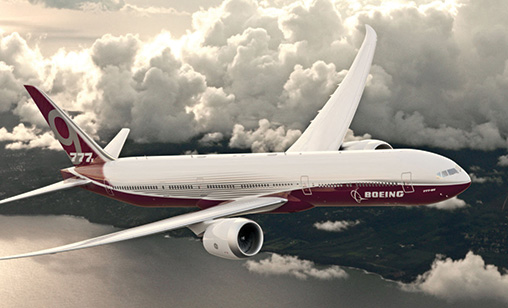News Backgrounder
Tough times ahead for wide body market
Certainty about the short term market for wide bodies has been eroded by reduced regional economic growth, an unstable security environment in Europe and hits to airline bookings from the Trump bans on travel and digital devices.
May 1st 2017
“Now I agree with John that the B787-9 is small, but I’m sure John knows that we have a B777X.” That was the riposte from Dinesh Keskar, Boeing’s senior vice-president sales Asia-Pacific and India, at the Orient Aviation Person of the Year dinner in March when the Airbus super salesman, John Leahy, quipped the Dreamliner was too small for non-stop flights from Australia to Europe. Read More »
Good natured ribbing aside, many in the industry hold the view that the wide body sector is saturated. Instead of more orders, deferrals, conversions and cancellations are ahead.
 |
In April, Boeing stoked speculation there was a fall off in appetite for wide bodies when it reduced the standard three-class layout for the B777-9X to 349 passengers. The change aligned the initially 400-plus-seater B777X closer to the 366-seat A350-1000 variant.
Until 2014, global sales were booming, with any fears of a capacity glut cast aside. The outlook was positive, no matter whom you asked. But events in the past 18 months have again left the industry in “challenging operational environments”.
Slower than predicted growth in China, a politically turbulent and insecure Europe and the Trump administration’s travel and electronics-on-flights bans have hurt more than just the Gulf carriers.
At the Airline Economics Growth Frontiers conference in Dublin in January, AerCap CEO, Angus Kelly, said the industry was in for “big deferrals in the wide body market” and that in the short term there is over-ordering because many airlines are chasing the same passengers.
Kelly said Airbus and Boeing order books do not reflect “what is going to be delivered” and that some carriers could cancel orders despite traffic growth continuing in the right direction.
“We see excess capacity in wide bodies as we look to the future of the industry,” said Ed Bastian, Delta Air Lines’ CEO, during a quarterly earnings call in April. He added the airline was in discussions with OEMs to tackle the issue.
“I think you could anticipate some reductions, broadly over the next several years,” he said. Delta has orders for 25 A350-900 and 25 A330neo wide bodies, but no Boeing jets. The A350s were earmarked to replace Delta’s B747-400s on routes to Asia.
United Airlines (UA) has questioned its own order for 35 A350-1000s, due for first delivery in 2018. “That’s an order we’re paying a lot of attention to and are considering different alternatives,” said chief financial officer, Andrew Levy, in February. United ordered the A350 in 2009 to replace its venerable B747-400s, but then announced a surprise order for 14 B777-300ERs last year. It planned to take delivery of all 14 of these jets by August. It has begun flying the aircraft from Hong Kong to San Francisco in lieu of its B747s. The San Francisco-Narita route will operate the -300ER from June.
American Airlines is in no hurry to take the A350. At press time, the Dallas/Fort Worth-based carrier again deferred delivery of its 22 on-order A350-900s by two years and now will take delivery of them from 2020 to 2024. Last July, American deferred the A350s from Spring 2017 to late 2018. The U.S. carrier also deferred two B787-9s from the second quarter of 2018 to the first quarter of 2019.
 |
According to American chief financial officer, Derek Kerr, the deferrals are a response to economic slowdowns abroad and to a decrease in the carrier’s near-term capital spending.
Emirates cancelled an order for 70 A350s in 2014 after reportedly being unhappy with weight and range changes Airbus made to the series. While Emirates might recommit to the A350 or weigh it against the B787-10, this seems very unlikely in the wake of Trump’s travel bans and their repercussions on Gulf carriers.
Last month, Emirates announced a significant reduction of its U.S. network. Flights to Boston, Los Angeles and Seattle will be reduced from twice daily to daily and Dubai to Fort Lauderdale and Orlando will be cut from daily to five-weekly.
Perhaps having bitten off more than it could chew with its order for 150 B777X, the airline is mulling single aisle aircraft for the first time, as Qatar Airways did last year when it ordered 60 B737 MAXs.
The A350-1000 programme was launched in 2007, six years before the B777X. Airbus has 211 orders globally for the -1000, including 124 from Asia-Pacific and Middle East airlines. The -1000’s market proposition is for 366 passengers in a standard three-class layout and a maximum range of 7,950 nautical miles.
Compared with the A350-1000, the B777X series secured more endorsements in a much shorter lead time following its launch at the 2013 Dubai Air Show. First delivery is on track for 2020 with 326 firm orders placed for the aircraft to date.
Of these, all but 20 of the airplanes are for Asia-Pacific and Middle Eastern airline customers. Emirates’ order makes up almost half of the book, with 150 B777Xs, which ties the programme’s success to the Gulf carrier. When the B777X was launched, it was meant to be larger than the -1000. Boeing pitched it as a 400-plus-seater with a range of 7,600nms.
Singapore Airlines (SIA), ever the trendsetter in the industry, ordered 20 B777Xs in February, having previously said it was considering the B777X and a further stretch to the A350—the -1000 and the “-2000”.
Boeing’s tell-tale April design modification for the B777X is sending the aircraft closer to the -1000 and even its own end-of-line B777-300ER. The B777-9X holds 349 passengers in a standard three-class cabin design, so the significantly reduced real estate is a more prudent and popular choice for customers in the uncertain wide body segment.
Although the B777-9X shares an external fuselage cross-section with the B777-300ER, Boeing engineers re-sculpted the internal sidewalls to carve out an extra 102mm of internal diameter: every little bit helps in a standard 10-abreast economy class cabin.
Boeing secured its 326 orders for the B777-9X quickly, but the majority of these orders are from the Middle East, which undoubtedly compromised its design for customers not operating in very hot conditions.
 |
 |
“The clean sheet designed A350-1000 is optimized for all types of operations,” Airbus’ Leahy told Orient Aviation. “It is 35 tonnes lighter in OWE, offering a 7% lower cost per seat and 400 nautical miles of additional range. As a result, it has double the customer base of the B777-9, with its 12 customers,” Leahy said.
The A350-900 is a different story altogether. It goes head-to-head with Boeing’s B787 series.
In the Asia-Pacific, in gross orders, the B787 series undeniably comes out ahead of the A350-900. Boeing received 1,211 global orders for the Dreamliner series to March 31. Of these, 559 orders, or 46%, were placed by carriers from this region and the Middle East.
Despite lengthy delays, the B787 had a head start on the A350. The first Dreamliner was delivered to All Nippon Airways (ANA) in September 2011. The first A350 entered service with Qatar Airways in January 2015. Nevertheless, the gap in development and production should no longer have any bearing on the current order backlogs.
Boeing’s 559 Asia-Pacific and Middle East orders for the B787 program compare to 313 orders from these regions for Airbus’ A350-900. The -900 had received 602 global orders as this issue went to press. With 313 going to Asian customers, 52% will operate from this region.
As such, one cannot blame Airbus for the B787 purchase bias. The culprits are the B787 arriving in the market three years earlier than the A350 and the continued success of the A330 in the region. However, the Dreamliner has been much more popular with Mainland Chinese carriers than the A350.
Air China has 15 B787-9s on order. China Eastern Airlines signed for 15. China Southern will receive 20. Juneyao Airlines has confirmed up to 10 -9s. Xiamen Airlines has twelve in its books. Ruili Airlines has booked six. Donghai Airlines will take five and the HNA Group carriers have confirmed orders for 40 B787s.
This compares to 10 and 20 A350s orders from Air China and China Eastern, respectively. After an unwelcome order drought, China Southern Airlines announced an order for 20 A350-900s on April 26. The Guangzhou-based carrier said the order will be delivered in three stages: six of the airplanes will arrive in 2019, another six in 2020, with four deliveries each in 2021 and 2022.
Airbus derives comfort from the fact that its A330 series, in production since the 1990s, continues to be popular with Mainland carriers. The OEM has sold 185 A330s to China since the launch of the B787 programme and there are more than 570 A330s in service at airlines across the region. The last big order was placed in October 2015, when Beijing committed to 30 A330s for its state-controlled carriers.
Airbus believes the A330’s popularity on the Mainland will ultimately translate into more Chinese orders for the A350. Its common type rating makes the A350 the perfect replacement and complement for A330 operators.
| 'At the Airline Economics Growth Frontiers conference in Dublin in January, AerCap CEO, Angus Kelly, said the industry was in for “big deferrals in the wide body market” and that in the short term, there is over-ordering because many airlines are chasing the same passengers. Kelly said Airbus and Boeing order books do not reflect “what is going to be delivered” and that some carriers could cancel orders despite traffic growth continuing in the right direction' |
Whatever the computations are for the region’s airlines, the general concensus among analysts is that for the rest of 2017 and into 2018, there will be a substantial wide body capacity glut in the market, both in the Asia-Pacific and the rest of the world.
Clearly, it is too late for Airbus and Boeing to cancel either the A350-1000 or the B777X. They would be ill-advised to do so anyway. Peaks and troughs come and go, but the general trend remains positive. Boeing expects demand for 9,100 wide bodies through to 2036. Airbus thinks there will be room for 9,543 large aircraft.
But the next two years will be tough. Airbus is predicting a book-to-bill ratio below 1 for 2017, meaning it expects fewer orders than deliveries for the first time in eight years. “We are fully booked in the years to come so it is not a surprise that the book-to-bill could be lower for some time,” Airbus and Airbus Commercial Aircraft chief financial officer, Harald Wilhelm, told a shareholder meeting in April. “At the same time, we are bringing up the production rates. In the long term, the outlook remains very positive.”
Also in April, Airbus’s Tom Enders said the Toulouse-based manufacturer expected to deliver more than 720 aircraft in 2017, a slightly improved forecast than its official guidance of “more than 700” deliveries.
There has long been talk of an even larger A350 variant, dubbed the “-2000” by Leahy. When last speaking to Orient Aviation, Airbus COO and president of its commercial aircraft division, Fabrice Brégier, remained ambivalent about the “-2000”. He said the OEM was studying its feasibility and was unsure if there was sufficient demand for such a large aircraft.